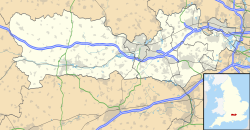| Tidmarsh | |
|---|---|
| Village and civil parish | |
 The 13th century Greyhound pub | |
Location within Berkshire | |
| Area | 7.02 km2 (2.71 sq mi) |
| Population | 501 (2011 census including Sulham) [1] |
| • Density | 71/km2 (180/sq mi) |
| OS grid reference | SU6374 |
| Civil parish |
|
| Unitary authority | |
| Ceremonial county | |
| Region | |
| Country | England |
| Sovereign state | United Kingdom |
| Post town | READING |
| Postcode district | RG8 |
| Dialling code | 0118 |
| Police | Thames Valley |
| Fire | Royal Berkshire |
| Ambulance | South Central |
| UK Parliament | |
Tidmarsh is a village and civil parish in the West Berkshire district, in the ceremonial county of Berkshire, England. Its development is mainly residential and agricultural, and is centred on the A340 road between Pangbourne and Theale. The rural area is bounded by the M4 motorway to the south. It is centred 1.5 miles (2.4 km) south of Pangbourne, 5.5 miles (8.9 km) west of Reading and 40 miles (64 km) west of London. Tidmarsh shares a grouped parish council with the neighbouring parish of Sulham. In 2021 the parish had a population of 414.


